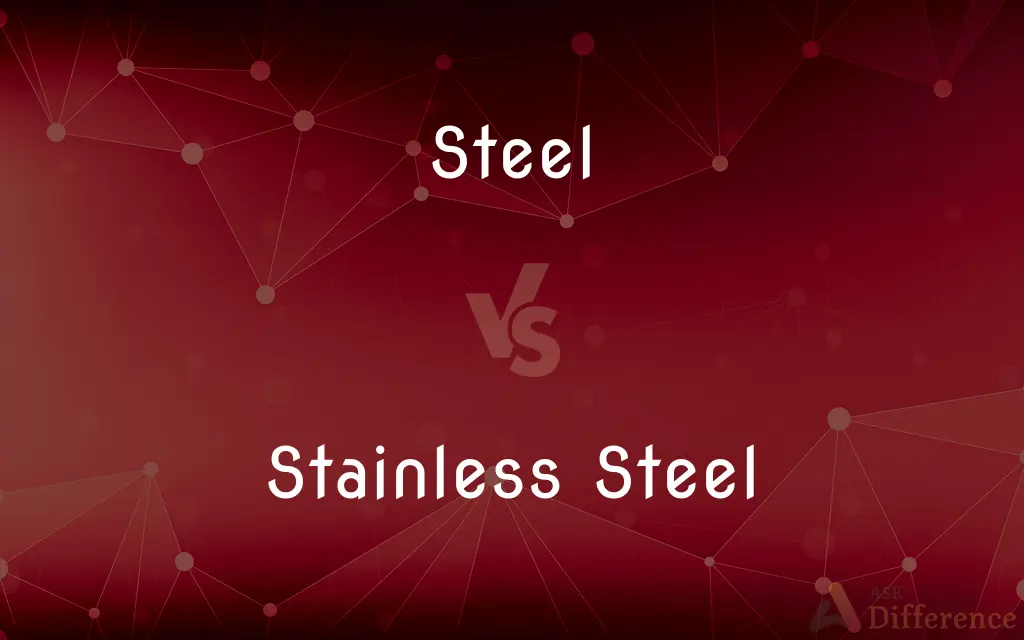Steel vs. Stainless Steel — What's the Difference?
By Tayyaba Rehman — Published on December 22, 2023
Steel is an alloy primarily of iron and carbon, known for its strength and versatility. Stainless Steel is a type of steel containing chromium, which provides resistance to rusting and corrosion.

Difference Between Steel and Stainless Steel
Table of Contents
ADVERTISEMENT
Key Differences
Steel, a widely used material in construction and manufacturing, primarily combines iron and carbon in its composition. The proportion of carbon and the methods of processing and treatment can give different types of Steel with varying properties. On the other hand, Stainless Steel is a specialized category within the steel family, formulated with added chromium.
The inclusion of chromium is what distinguishes Stainless Steel from regular Steel. When Steel is exposed to oxygen, it can rust or corrode over time. However, with Stainless Steel, the chromium present forms a thin layer of chromium oxide on the surface, acting as a protective barrier against rusting or staining. This makes Stainless Steel an excellent choice for environments where corrosion resistance is paramount.
In terms of appearance, Steel can take on a darker hue, especially as it oxidizes. Stainless Steel, owing to its chromium content, often has a shinier, more polished appearance. This aesthetic difference makes Stainless Steel a popular choice for kitchen appliances, cutlery, and other decorative applications.
While both Steel and Stainless Steel are renowned for their strength, their areas of application can vary. Regular Steel, being more malleable, is often used where shaping, welding, and crafting are essential. Stainless Steel, with its anti-corrosive properties, finds its place in environments where moisture is prevalent or where hygiene is a concern, such as in medical instruments.
From a cost perspective, Stainless Steel tends to be more expensive than regular Steel. This price difference can be attributed to the addition of chromium and the processes involved in ensuring the anti-corrosive properties of Stainless Steel.
ADVERTISEMENT
Comparison Chart
Primary Components
Iron and carbon
Iron, carbon, and at least 10.5% chromium
Corrosion Resistance
Prone to rusting and corrosion
Resistant to rusting and corrosion
Appearance
Can be darker, especially when oxidized
Shiny and often more polished
Typical Usage
Construction, car manufacturing, tools
Kitchenware, medical instruments, marine applications
Cost
Generally less expensive
More expensive due to chromium content and manufacturing
Compare with Definitions
Steel
Steel is an alloy primarily composed of iron and carbon.
The skyscraper's frame was made entirely of Steel.
Stainless Steel
Stainless Steel is renowned for its resistance to corrosion.
For marine applications, Stainless Steel was chosen due to its durability.
Steel
The properties of Steel can vary based on carbon content and treatment.
High carbon Steel is harder but less ductile.
Stainless Steel
Stainless Steel has a broad range of applications, from kitchenware to medical instruments.
Surgeons prefer Stainless Steel tools for their hygienic properties.
Steel
A generally hard, strong, durable, malleable alloy of iron and carbon, usually containing between 0.2 and 1.5 percent carbon, often with other constituents such as manganese, chromium, nickel, molybdenum, copper, tungsten, cobalt, or silicon, depending on the desired alloy properties, and widely used as a structural material.
Stainless Steel
The chromium in Stainless Steel forms a protective layer against rusting.
Even after years of use, the Stainless Steel cutlery remained spotless.
Steel
Something, such as a sword, that is made of steel.
Stainless Steel
Stainless Steel is a steel alloy with a minimum of 10.5% chromium content.
The kitchen sink made of Stainless Steel was shiny and resistant to rust.
Steel
A quality suggestive of this alloy, especially a hard, unflinching character.
Stainless Steel
Stainless Steel often has a polished and clean appearance.
The Stainless Steel watch gleamed under the store lights.
Steel
Steel gray.
Stainless Steel
Alternative spelling of stainless steel
Steel
Made with, relating to, or consisting of steel
Steel beams.
The steel industry.
A bicycle with a steel frame.
Steel
Very firm or strong
A steel grip.
Steel
Of a steel gray.
Steel
To cover, plate, edge, or point with steel.
Steel
To make hard, strong, or obdurate; strengthen
He steeled himself for disappointment.
Steel
An artificial metal produced from iron, harder and more elastic than elemental iron; used figuratively as a symbol of hardness.
Steel
(countable) Any item made of this metal, particularly including:
Steel
Bladed or pointed weapons, as swords, javelins, daggers.
Steel
A piece used for striking sparks from flint.
Steel
Armor.
Steel
A honing steel, a tool used to sharpen or hone metal blades.
Steel
(sewing) Pieces used to strengthen, support, or expand an item of clothing.
Steel
(dialectal) A flat iron.
Steel
A sewing needle; a knitting needle; a sharp metal stylus.
Steel
(printing) An engraving plate:
Steel
Projectiles.
Steel
(sewing) A fringe of beads or decoration of this metal.
Steel
A type of slide used while playing the steel guitar.
Steel
Medicinal consumption of this metal; chalybeate medicine; (eventually) any iron or iron-treated water consumed as a medical treatment.
Steel
(countable) Varieties of this metal.
Steel
The gray hue of this metal; steel-gray, or steel blue.
Steel
(figurative) Extreme hardness or resilience.
Steel
Made of steel.
Steel
Similar to steel in color, strength, or the like; steely.
Steel
(business) Of or belonging to the manufacture or trade in steel.
Steel
Containing steel.
Steel
(printing) Engraved on steel.
Steel
(transitive) To edge, cover, or point with steel.
Steel
(transitive) To harden or strengthen; to nerve or make obdurate; to fortify against.
Steel
To back with steel.
Steel
To treat a liquid with steel for medicinal purposes.
Steel
To press with a flat iron.
Steel
To cause to resemble steel in appearance.
Steel
(transitive) To steelify; to turn iron into steel.
Steel
(transitive) To electroplate an item, particularly an engraving plate, with a layer of iron.
Steel
(transitive) To sharpen with a honing steel.
Steel
Coldbath Fields Prison in London, closed in 1877.
Steel
A variety of iron intermediate in composition and properties between wrought iron and cast iron (containing between one half of one per cent and one and a half per cent of carbon), and consisting of an alloy of iron with an iron carbide. Steel, unlike wrought iron, can be tempered, and retains magnetism. Its malleability decreases, and fusibility increases, with an increase in carbon.
Steel
An instrument or implement made of steel
Steel
A weapon, as a sword, dagger, etc.
While doubting thus he stood,Received the steel bathed in his brother's blood.
Steel
Fig.: Anything of extreme hardness; that which is characterized by sternness or rigor.
Steel
An instrument of steel (usually a round rod) for sharpening knives.
Steel
A chalybeate medicine.
Steel
A piece of steel for striking sparks from flint.
Steel
To overlay, point, or edge with steel; as, to steel a razor; to steel an ax.
Steel
To make hard or strong; hence, to make insensible or obdurate.
Lies well steeled with weighty arguments.
O God of battles! steel my soldiers' hearts.
Why will you fight against so sweet a passion,And steel your heart to such a world of charms?
Steel
To cause to resemble steel, as in smoothness, polish, or other qualities.
These waters, steeledBy breezeless air to smoothest polish.
Steel
To cover, as an electrotype plate, with a thin layer of iron by electrolysis. The iron thus deposited is very hard, like steel.
Steel
An alloy of iron with small amounts of carbon; widely used in construction; mechanical properties can be varied over a wide range
Steel
A cutting or thrusting weapon with a long blade
Steel
Knife sharpener consisting of a ridged steel rod
Steel
Get ready for something difficult or unpleasant
Steel
Cover, plate, or edge with steel
Steel
Steel is known for its strength and durability.
The Steel beams provided structural integrity to the bridge.
Steel
Steel is used widely in construction and manufacturing.
Automakers use Steel for its combination of strength and malleability.
Steel
Steel can be shaped, welded, and crafted for various applications.
The artist sculpted an intricate design from a block of Steel.
Common Curiosities
Why is Stainless Steel used in kitchen appliances?
Stainless Steel is both aesthetically pleasing and resistant to stains and corrosion.
What's the primary difference between Steel and Stainless Steel?
Steel is primarily iron and carbon, while Stainless Steel contains added chromium for corrosion resistance.
Can Steel be made rust-resistant like Stainless Steel?
While treatments can improve Steel's resistance, it won't be as naturally resistant as Stainless Steel.
Why does Stainless Steel resist rusting?
The chromium in Stainless Steel forms a protective layer that prevents rusting.
Can Steel be magnetized?
Yes, most Steel types can be magnetized, but some Stainless Steel variants are non-magnetic.
Is Stainless Steel always shiny?
While often polished to a shine, Stainless Steel can have different finishes, including matte.
Is Stainless Steel safe for cooking?
Yes, Stainless Steel is considered safe and hygienic for cooking.
Why is Stainless Steel more expensive?
The addition of chromium and the processes to ensure its properties contribute to the higher cost.
Are there different grades of Stainless Steel?
Yes, Stainless Steel comes in various grades based on components and intended use.
Which is heavier, Steel or Stainless Steel?
Their weight is comparable, but slight differences can arise based on specific alloy compositions.
Can both Steel and Stainless Steel be welded?
Yes, though the methods and outcomes might vary due to their properties.
What gives Steel its strength?
The combination of iron and carbon in Steel gives it its strength.
Share Your Discovery

Previous Comparison
Soy Lecithin vs. Sunflower Lecithin
Next Comparison
Full Bed vs. Queen BedAuthor Spotlight
Written by
Tayyaba RehmanTayyaba Rehman is a distinguished writer, currently serving as a primary contributor to askdifference.com. As a researcher in semantics and etymology, Tayyaba's passion for the complexity of languages and their distinctions has found a perfect home on the platform. Tayyaba delves into the intricacies of language, distinguishing between commonly confused words and phrases, thereby providing clarity for readers worldwide.
















































